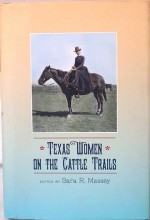Texas Women on the Cattle Trails tells the stories of sixteen women who drove cattle up the trail from Texas during the last half of the nineteenth century.
Some were young; some were old (over thirty). Some took to the trails by choice; others, out of necessity. Some went along to look at the stars; others, to work the cattle. Some made money and built ranching empires, but others went broke and lived hard, even desperate lives. The courage of Margaret Borland and the spunk of Willie Matthews, the pure delight of Cornelia Adair viewing the buffalo, and the joy of Mary Bunton gazing at night constellations on the open range offer new insights into women’s experiences of the West.
For the most part, these were ordinary women doing the best they could in difficult frontier conditions. They did not see themselves as living in unusual times or participating in "romantic" lifestyles, although the women who actually took to the trail were few in number. Like the cowboys on cattle drives, they faced dust and heat, thirst and exhaustion, rustlers and Indians, stampedes and prairie fires.
Drawing heavily on the accounts of the women themselves, the authors of these chapters vividly illustrate the complexity and diversity of women’s experiences on the cattle trails. Their stories of cattle drives and moving cattle to distant pastures add an important chapter to the story of life in the real Old West.
Texas Women on the Cattle Trail
By Cindy W. Bonner
Almost everyone has heard of Annie Oakley, Belle Starr, and Calamity Jane. But how about Kate Medlin, Hattie Cluck, Margaret Borland or Cornelia Adair? These are just four of the sixteen fearless women featured in "TEXAS WOMAN ON THE CATTLE TRAILS," a compendium of short biographies written by sixteen Texas writers, and edited by Austwell resident Sara R. Massey.
Some of the featured women were young newlyweds when they went up the trail. Others were middle-aged mothers, and one was pregnant. They were widows, business women, heiresses. Some were cultured and educated. Almost all encountered Indians, bandits or rustlers. They endured blizzards, floods, stampedes, disease, death. They made deals with cattle buyers and sellers. They witnessed a new country in its earliest growing pains, and most lived to tell their tales, even to embellish them over time.
Take Minta Corum Holmsley of Comanche, Texas, who rode her horse up the trail sidesaddle, she said, "because we didn't have better sense." On that drive she claimed to have met John Wesley Hardin masquerading as an Indian, and later to have encountered a hundred Sioux who had fought Custer at the Battle of Little Bighorn. She managed to save her favorite cow pony by screaming in one Indian's face until he let go and fled in fright.
Another woman, the widowed Margaret Heffernon Borland of Victoria lost four of her seven children to one epidemic of Yellow Fever. And Margaret herself died at the end of her own cattle drive in 1873. The Wichita, Kansas newspaper announced her death on July 5, at the age of 49, as having been caused by "mania, super-induced by her long, tedious journey and over-taxation of the brain." Her nephew had her body shipped back to Victoria and she is buried in the Evergreen Cemetery....
By Dennis Mccown
There's enough excitement and derring-do in J. Marvin Hunter's "Trail Drivers of Texas" for anyone interested in the Old West, but out of curiousity, I picked up a new book on the cattle drives, "Texas Women on the Cattle Trails."
To my pleasant surprise, the book was every bit as good as Hunter's great classic. Edited by Sara R. Massey, this new volume features the stories of sixteen remarkable women who either accompanied their husbands up the trail or managed herds on their own. Facing the same hazards as the men, these women rode astride or sidesaddle, drove buggies or wagons, and endured thirst, danger, storm, and stampedes. None of these women were common people; all exhibited above-average ambition and courage. Most went on to lead successful lives, but their stories, ably told by eighteen knowledgeable contributors, are not altogether happy ones. Even so, the book is interesting, thrilling, and inspiring. A good addition to anyone's Old West collection.
By Michele J. Samuelson
It's a tall order, because there are so many good books on Texas history, but Sara Massey's book really shines. I've always been a sucker for cattle trail tails, and I was deep into Haley's book on Charles Goodnight when I went down to Gonzales for a book fair and signing. I missed the author, but picked up Texas Women on the Cattle Trails anyway. From the moment I started reading, I couldn't put it down!
The information gathered is well-researched and each of the stories entertainingly written. I very much appreciated information, where available, on burial sites and original homesites - thanks to this book, I was able to find Harriet Cluck's gravesite in Cedar Park, making an educational reading experience a personally affecting one as well. I learned a great deal more about the town just by reading this book.
This oughta be on the required reading lists in Texas history courses at universities (wouldn't hurt for women's studies majors to read it as well). Texas Women on the Cattle Trails provides provocative and enlightening information on a well-canvassed but rarely understood portion of Texas history.
... that women were so active in the great days of the long-trail western cattle drives? I especially relished learning about Lizzie Johnson Williams, school-teacher turned accountant turned writer turned cattle ranch owner. The chapter about her - a late 20th century independent woman in the middle of the 19th is an eye-opener and is worth the price of the whole rest of the book.
By Terrie L. Todd
I have really enjoyed this book it is historically correct and well referencedit has been a big help in my research.

